Efficacy of Heterologous Vaccination Using Virus-Like Particles and Vaccinia Virus Containing MIC8 and AMA1 Proteins of Toxoplasma gondii
Abstract
1. Introduction
2. Materials and Methods
2.1. Ethical Statement
2.2. Parasite
2.3. Generation of VLPs and rVVs Presenting T. gondii MIC8 or AMA1
2.4. Western Blot Analysis
2.5. Vaccination and Challenge Infection
2.6. Measurement of T. gondii-Specific IgG in Serum
2.7. Quantification of Antibodies from Antibody-Secreting Cells (ASCs)
2.8. Flow Cytometry
2.9. Statistical Analysis
3. Results
3.1. MIC8 and AMA1 Containing VLPs and rVVs Were Successfully Generated and Characterized
3.2. Serum IgG Response Was Significantly Higher in the VLP + VLP Group than in the rVV + VLP Group
3.3. IgG2a and IgG2b Production by ASCs Was Higher in the rVV + VLP Group than in the VLP + VLP Group
3.4. CD4+ and CD8+ T Cell and Memory B Cell Responses Were Significantly Higher in the rVV + VLP Group
3.5. rVV + VLP Vaccination Led to Complete Survival and Reduced Brain Cyst Counts
4. Discussion
5. Conclusions
Author Contributions
Funding
Institutional Review Board Statement
Informed Consent Statement
Data Availability Statement
Conflicts of Interest
References
- Attias, M.; Teixeira, D.E.; Benchimol, M.; Vommaro, R.C.; Crepaldi, P.H.; De Souza, W. The life-cycle of Toxoplasma gondii reviewed using animations. Parasites Vectors 2020, 13, 1–13. [Google Scholar] [CrossRef]
- Watts, E.; Zhao, Y.; Dhara, A.; Eller, B.; Patwardhan, A.; Sinai, A.P. Novel approaches reveal that Toxoplasma gondii bradyzoites within tissue cysts are dynamic and replicating entities in vivo. MBio 2015, 6, e01155-15. [Google Scholar] [CrossRef]
- Jafari, M.M.; Tabrizi, Z.A.; Dayer, M.S.; Kazemi-Sefat, N.A.; Mohtashamifard, M.; Mohseni, R.; Bagheri, A.; Bahadory, S.; Karimipour-Saryazdi, A.; Ghaffarifar, F. Immune system roles in pathogenesis, prognosis, control, and treatment of Toxoplasma gondii infection. Int. Immunopharmacol. 2023, 124, 110872. [Google Scholar] [CrossRef]
- Yap, G.S.; Sher, A. Cell-mediated immunity to Toxoplasma gondii: Initiation, regulation and effector function. Immunobiology 1999, 201, 240–247. [Google Scholar] [CrossRef]
- Hunter, C.A.; Sibley, L.D. Modulation of innate immunity by Toxoplasma gondii virulence effectors. Nat. Rev. Microbiol. 2012, 10, 766–778. [Google Scholar] [CrossRef]
- Werk, R. How does Toxoplasma gondii enter host cells? Rev. Infect. Dis. 1985, 7, 449–457. [Google Scholar] [CrossRef] [PubMed]
- Kessler, H.; Herm-Götz, A.; Hegge, S.; Rauch, M.; Soldati-Favre, D.; Frischknecht, F.; Meissner, M. Microneme protein 8–a new essential invasion factor in Toxoplasma gondii. J. Cell Sci. 2008, 121, 947–956. [Google Scholar] [CrossRef]
- Carruthers, V.B.; Giddings, O.K.; Sibley, L.D. Secretion of micronemal proteins is associated with Toxoplasma invasion of host cells. Cell. Microbiol. 1999, 1, 225–235. [Google Scholar] [CrossRef] [PubMed]
- Lee, S.-H.; Kang, H.-J.; Lee, D.-H.; Kang, S.-M.; Quan, F.-S. Virus-like particle vaccines expressing Toxoplasma gondii rhoptry protein 18 and microneme protein 8 provide enhanced protection. Vaccine 2018, 36, 5692–5700. [Google Scholar] [CrossRef] [PubMed]
- Kim, M.-J.; Lee, S.-H.; Kang, H.-J.; Chu, K.-B.; Park, H.; Jin, H.; Moon, E.-K.; Kim, S.S.; Quan, F.-S. Virus-like particle vaccine displaying Toxoplasma gondii apical membrane antigen 1 induces protection against T. gondii ME49 infection in mice. Microb. Pathog. 2020, 142, 104090. [Google Scholar] [CrossRef]
- Sun, H.; Chen, X.; Wang, Y. Strategies for the Modification of Vaccinia Virus towards a Better Vaccine Vector. Zoonoses 2025, 5, 994. [Google Scholar] [CrossRef]
- Harrington, L.E.; Most, R.v.d.; Whitton, J.L.; Ahmed, R. Recombinant vaccinia virus-induced T-cell immunity: Quantitation of the response to the virus vector and the foreign epitope. J. Virol. 2002, 76, 3329–3337. [Google Scholar] [CrossRef] [PubMed]
- Crotty, S.; Felgner, P.; Davies, H.; Glidewell, J.; Villarreal, L.; Ahmed, R. Cutting edge: Long-term B cell memory in humans after smallpox vaccination. J. Immunol. 2003, 171, 4969–4973. [Google Scholar] [CrossRef]
- Venkatraman, N.; Anagnostou, N.; Bliss, C.; Bowyer, G.; Wright, D.; Lövgren-Bengtsson, K.; Roberts, R.; Poulton, I.; Lawrie, A.; Ewer, K. Safety and immunogenicity of heterologous prime-boost immunization with viral-vectored malaria vaccines adjuvanted with Matrix-M™. Vaccine 2017, 35, 6208–6217. [Google Scholar] [CrossRef] [PubMed]
- Bhatnagar, N.; Kim, K.-H.; Subbiah, J.; Muhammad-Worsham, S.; Park, B.R.; Liu, R.; Grovenstein, P.; Wang, B.-Z.; Kang, S.-M. Heterologous Prime-Boost Vaccination with Inactivated Influenza Viruses Induces More Effective Cross-Protection than Homologous Repeat Vaccination. Vaccines 2023, 11, 1209. [Google Scholar] [CrossRef] [PubMed]
- Zhang, J.; He, Q.; An, C.; Mao, Q.; Gao, F.; Bian, L.; Wu, X.; Wang, Q.; Liu, P.; Song, L. Boosting with heterologous vaccines effectively improves protective immune responses of the inactivated SARS-CoV-2 vaccine. Emerg. Microbes Infect. 2021, 10, 1598–1608. [Google Scholar] [CrossRef]
- Ho, T.-C.; Chen, Y.-M.A.; Chan, H.-P.; Chang, C.-C.; Chuang, K.-P.; Lee, C.-H.; Yuan, C.-H.; Tyan, Y.-C.; Yang, M.-H. The effects of heterologous immunization with prime-boost COVID-19 vaccination against SARS-CoV-2. Vaccines 2021, 9, 1163. [Google Scholar] [CrossRef]
- Kang, H.-J.; Lee, S.-H.; Kim, M.-J.; Chu, K.-B.; Lee, D.-H.; Chopra, M.; Choi, H.-J.; Park, H.; Jin, H.; Quan, F.-S. Influenza virus-like particles presenting both Toxoplasma gondii ROP4 and ROP13 Enhance Protection against T. gondii infection. Pharmaceutics 2019, 11, 342. [Google Scholar] [CrossRef]
- Yoon, K.-W.; Chu, K.-B.; Kang, H.-J.; Kim, M.-J.; Eom, G.-D.; Quan, F.-S. Orally administrated recombinant vaccinia virus displaying ROP4 induces protection against Toxoplasma gondii challenge infection. Vaccines 2022, 10, 152. [Google Scholar] [CrossRef]
- Kim, M.-J.; Chu, K.B.; Yoon, K.-W.; Kang, H.-J.; Lee, D.-H.; Moon, E.-K.; Quan, F.-S. Virus-like particles expressing microneme-associated antigen of Plasmodium berghei confer better protection than those expressing apical membrane antigen 1. Parasites Hosts Dis. 2024, 62, 193. [Google Scholar] [CrossRef]
- Hanson, C.H.; Henry, B.; Andhare, P.; Lin, F.J.; Pak, H.; Turner, J.S.; Adams, L.J.; Liu, T.; Fremont, D.H.; Ellebedy, A.H. CD62L expression marks a functionally distinct subset of memory B cells. Cell Rep. 2023, 42. [Google Scholar] [CrossRef] [PubMed]
- Zabalza, A.; Vera, A.; Alari-Pahissa, E.; Munteis, E.; Moreira, A.; Yélamos, J.; Llop, M.; López-Botet, M.; Martínez-Rodríguez, J.E. Impact of cytomegalovirus infection on B cell differentiation and cytokine production in multiple sclerosis. J. Neuroinflammation 2020, 17, 1–8. [Google Scholar] [CrossRef] [PubMed]
- Syomin, B.; Ilyin, Y. Virus-like particles as an instrument of vaccine production. Mol. Biol. 2019, 53, 323–334. [Google Scholar] [CrossRef]
- Mohsen, M.O.; Zha, L.; Cabral-Miranda, G.; Bachmann, M.F. Major findings and recent advances in virus–like particle (VLP)-based vaccines. Semin. Immunol. 2017, 34, 123–132. [Google Scholar]
- Shakya, A.K.; Chowdhury, M.Y.; Tao, W.; Gill, H.S. Mucosal vaccine delivery: Current state and a pediatric perspective. J. Control. Release 2016, 240, 394–413. [Google Scholar] [CrossRef]
- Romagnani, S. Induction of TH1 and TH2 responses: A key role for the ‘natural’immune response? Immunol. Today 1992, 13, 379–381. [Google Scholar] [CrossRef]
- Tan, F.; Hu, X.; Luo, F.-J.; Pan, C.-W.; Chen, X.-G. Induction of protective Th1 immune responses in mice by vaccination with recombinant Toxoplasma gondii nucleoside triphosphate hydrolase-II. Vaccine 2011, 29, 2742–2748. [Google Scholar] [CrossRef]
- Denkers, E.Y.; Gazzinelli, R.T. Regulation and function of T-cell-mediated immunity during Toxoplasma gondii infection. Clin. Microbiol. Rev. 1998, 11, 569–588. [Google Scholar] [CrossRef]
- Gigley, J.P.; Fox, B.A.; Bzik, D.J. Cell-mediated immunity to Toxoplasma gondii develops primarily by local Th1 host immune responses in the absence of parasite replication. J. Immunol. 2009, 182, 1069–1078. [Google Scholar] [CrossRef]
- Szabo, S.J.; Sullivan, B.M.; Stemmann, C.; Satoskar, A.R.; Sleckman, B.P.; Glimcher, L.H. Distinct effects of T-bet in TH1 lineage commitment and IFN-γ production in CD4 and CD8 T cells. Science 2002, 295, 338–342. [Google Scholar] [CrossRef]
- Zhang, Y.; Jiang, N.; Zhang, T.; Wang, D.; Feng, Y.; Sang, X.; Yang, N.; Chen, Q. Toxoplasma gondii genotype determines Tim-3 expression levels in splenic and circulatory T cells in mice. Front. Microbiol. 2018, 9, 2967. [Google Scholar] [CrossRef] [PubMed]
- McHeyzer-Williams, M.; Okitsu, S.; Wang, N.; McHeyzer-Williams, L. Molecular programming of B cell memory. Nat. Rev. Immunol. 2012, 12, 24–34. [Google Scholar] [CrossRef]
- Luckheeram, R.V.; Zhou, R.; Verma, A.D.; Xia, B. CD4+ T cells: Differentiation and functions. J. Immunol. Res. 2012, 2012, 925135. [Google Scholar] [CrossRef]
- Inoue, T. Memory B cell differentiation from germinal centers. Int. Immunol. 2023, 35, 565–570. [Google Scholar] [CrossRef] [PubMed]
- Ronda, C.; Vázquez, M. European journals of microbiology. Microbiology 1997, 13, 499–508. [Google Scholar]
- de Medeiros Brito, R.M.; Meurer, Y.d.S.R.; Batista, J.A.L.; de Sá, A.L.; de Medeiros Souza, C.R.; de Souto, J.T.; de Andrade-Neto, V.F. Chronic Toxoplasma gondii infection contributes to perineuronal nets impairment in the primary somatosensory cortex. Parasites Vectors 2022, 15, 487. [Google Scholar] [CrossRef] [PubMed]
- Eom, G.-D.; Chu, K.B.; Mao, J.; Yoon, K.-W.; Kang, H.-J.; Moon, E.-K.; Kim, S.S.; Quan, F.-S. Heterologous immunization targeting the CST1 antigen confers better protection than ROP18 in mice. Nanomedicine 2024, 19, 2437–2446. [Google Scholar] [CrossRef]
- Eom, G.-D.; Chu, K.-B.; Kang, H.-J.; Kim, M.-J.; Yoon, K.-W.; Mao, J.; Lee, S.-H.; Ahmed, M.A.; Moon, E.-K.; Quan, F.-S. Protective mucosal and systemic immunity induced by virus-like particles expressing Toxoplasma gondii cyst wall protein. PLoS ONE 2023, 18, e0283928. [Google Scholar] [CrossRef]
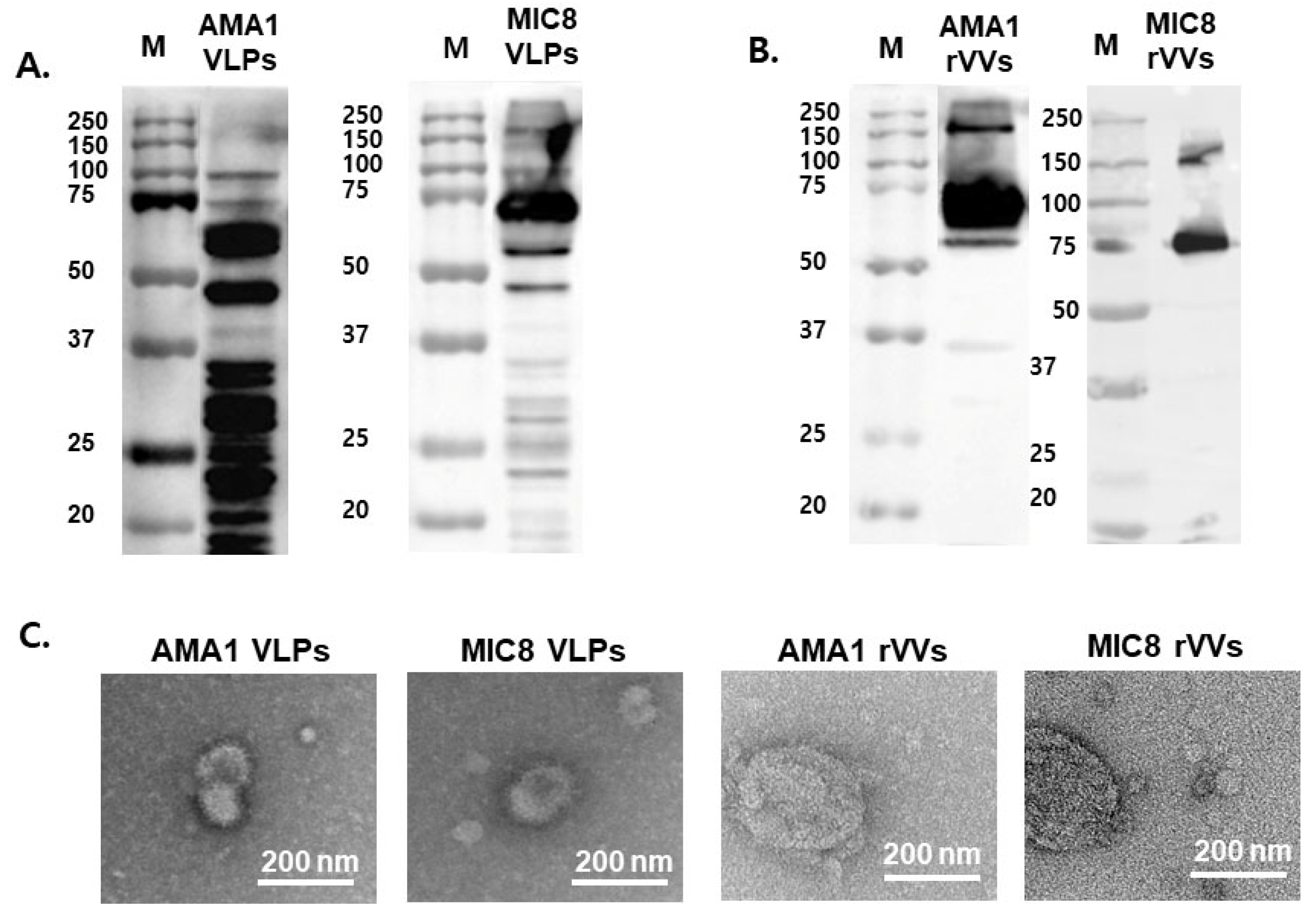

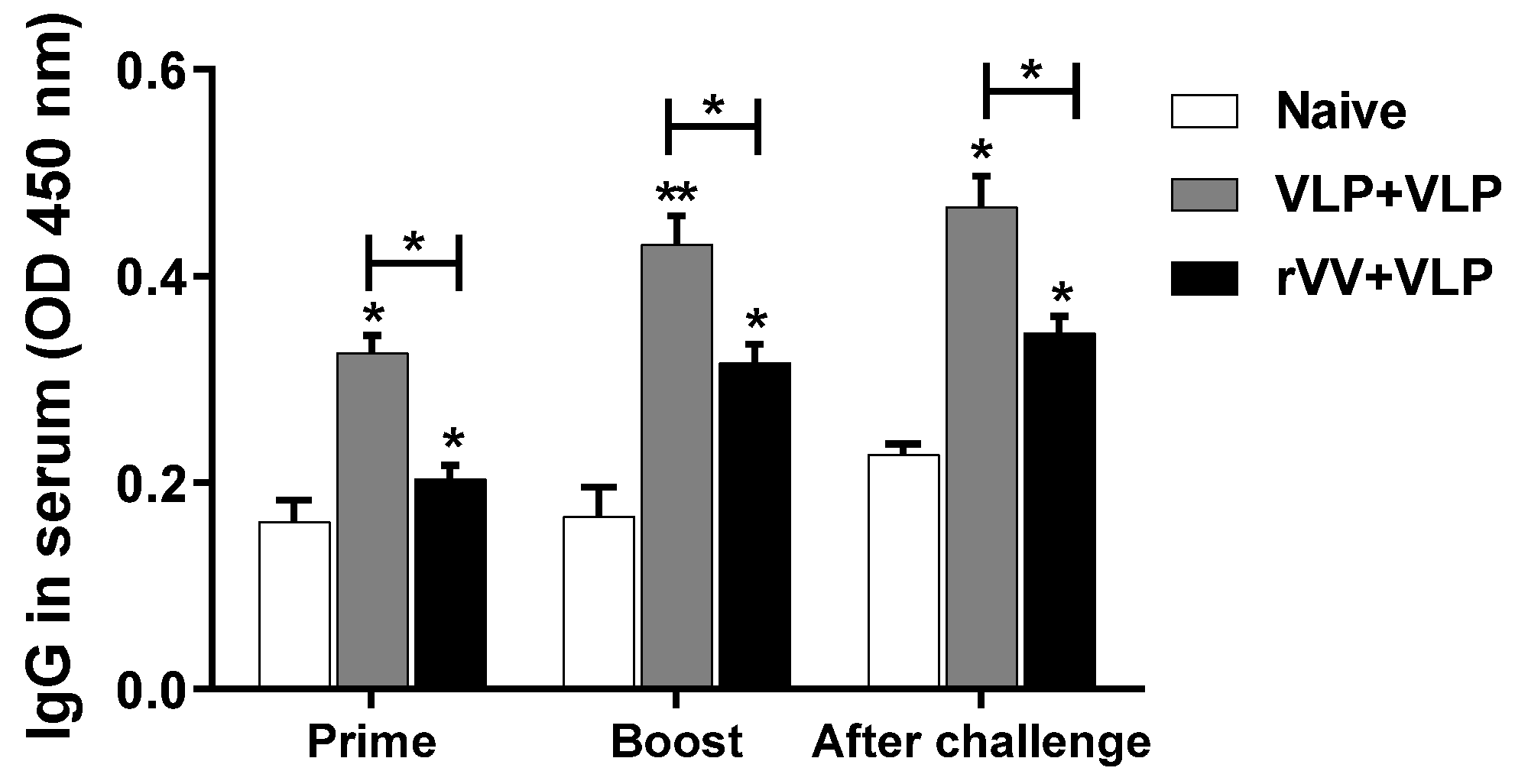
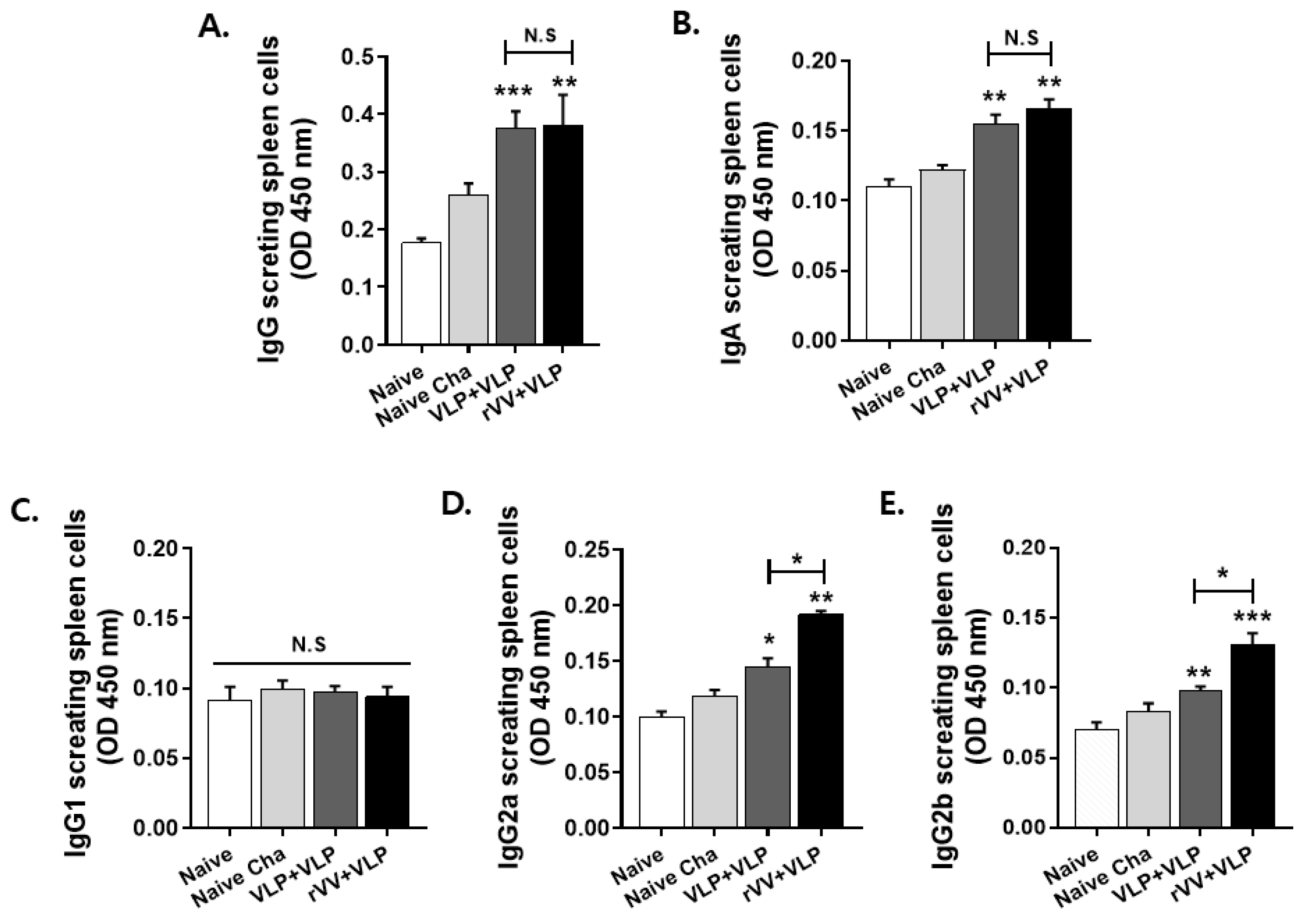
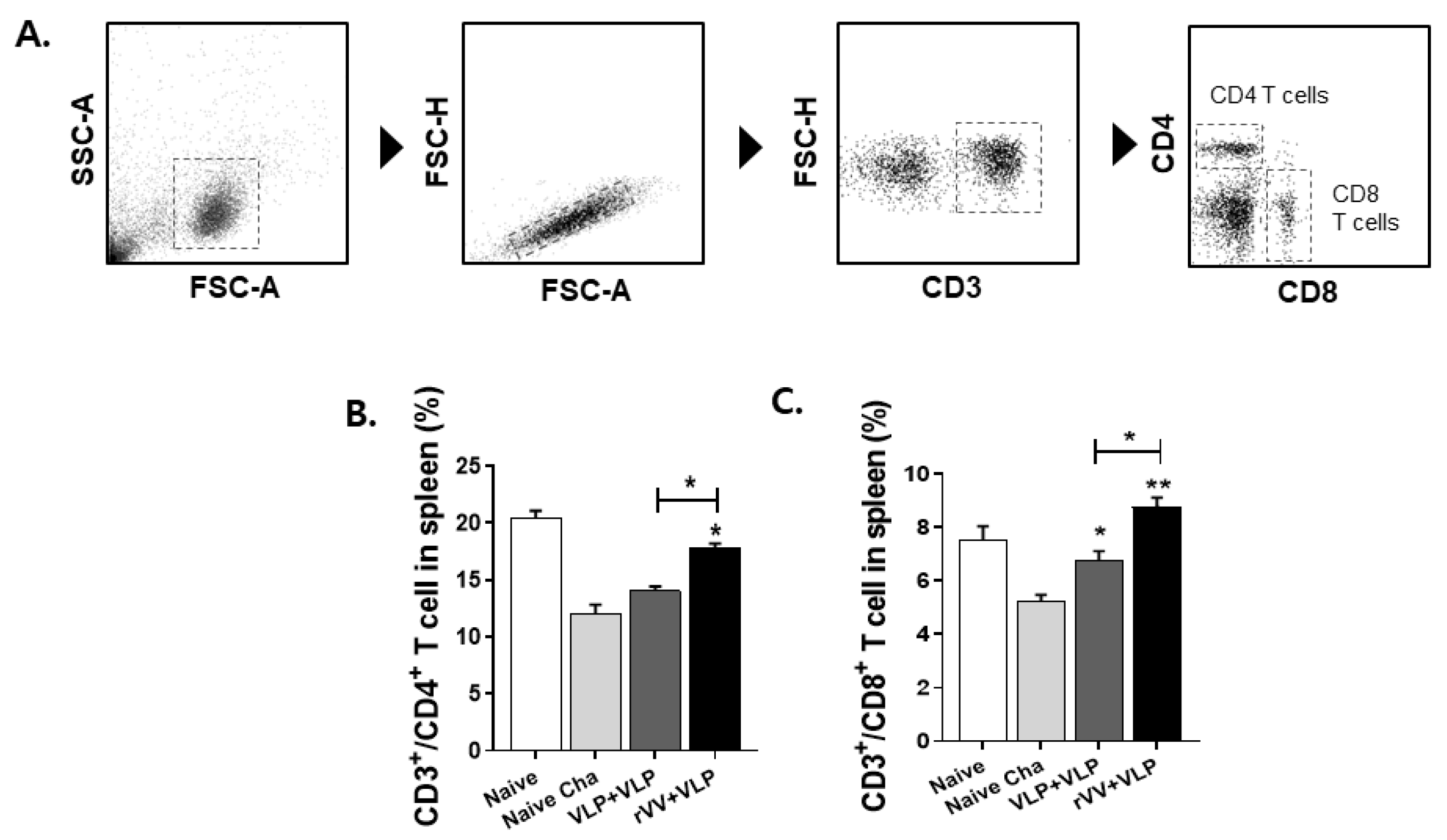
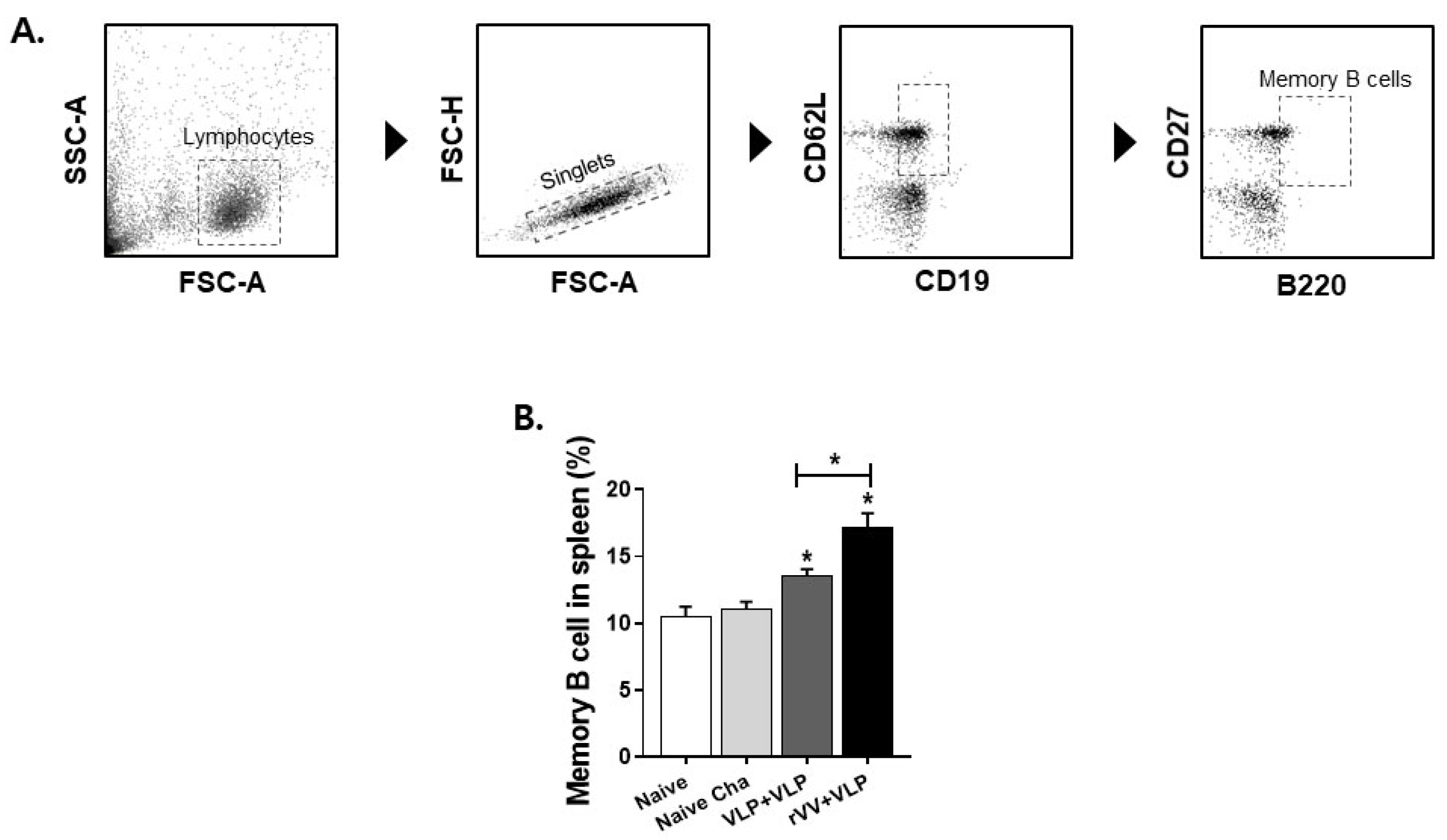

Disclaimer/Publisher’s Note: The statements, opinions and data contained in all publications are solely those of the individual author(s) and contributor(s) and not of MDPI and/or the editor(s). MDPI and/or the editor(s) disclaim responsibility for any injury to people or property resulting from any ideas, methods, instructions or products referred to in the content. |
© 2025 by the authors. Licensee MDPI, Basel, Switzerland. This article is an open access article distributed under the terms and conditions of the Creative Commons Attribution (CC BY) license (https://creativecommons.org/licenses/by/4.0/).
Share and Cite
Kang, H.-J.; Quan, F.-S. Efficacy of Heterologous Vaccination Using Virus-Like Particles and Vaccinia Virus Containing MIC8 and AMA1 Proteins of Toxoplasma gondii. Vaccines 2025, 13, 862. https://doi.org/10.3390/vaccines13080862
Kang H-J, Quan F-S. Efficacy of Heterologous Vaccination Using Virus-Like Particles and Vaccinia Virus Containing MIC8 and AMA1 Proteins of Toxoplasma gondii. Vaccines. 2025; 13(8):862. https://doi.org/10.3390/vaccines13080862
Chicago/Turabian StyleKang, Hae-Ji, and Fu-Shi Quan. 2025. "Efficacy of Heterologous Vaccination Using Virus-Like Particles and Vaccinia Virus Containing MIC8 and AMA1 Proteins of Toxoplasma gondii" Vaccines 13, no. 8: 862. https://doi.org/10.3390/vaccines13080862
APA StyleKang, H.-J., & Quan, F.-S. (2025). Efficacy of Heterologous Vaccination Using Virus-Like Particles and Vaccinia Virus Containing MIC8 and AMA1 Proteins of Toxoplasma gondii. Vaccines, 13(8), 862. https://doi.org/10.3390/vaccines13080862





